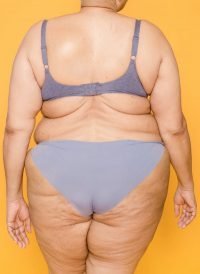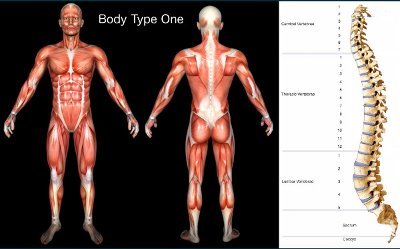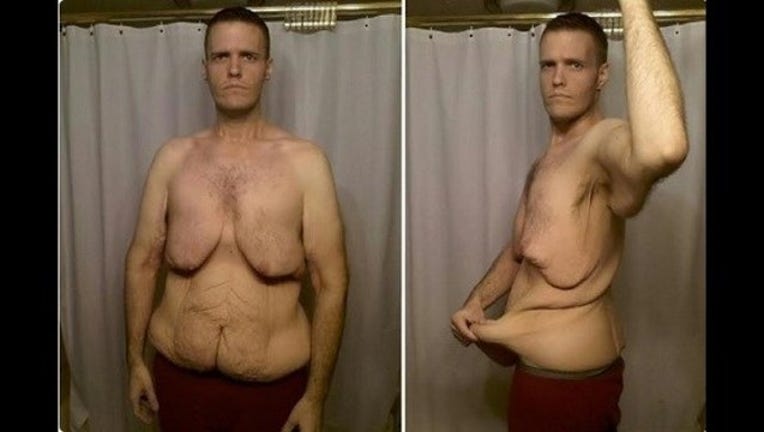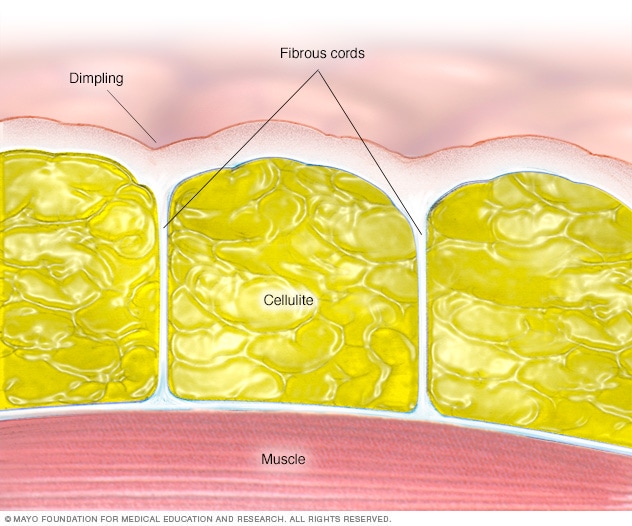Cellulite
Accepting that differences in genetics/DNA are a given, explanations abound as to why some human bodies have cellulite and others do not. One thing is for sure, some human bodies do have cellulite/skinny fat, and some human bodies do NOT have cellulite/skinny fat.
MAINSTREAM SCIENCE & MEDICAL DOCTOR’S CELLULITE EXPLANATIONS INCLUDE:
*Hormone Imbalances
*Extra Gender-Specific Fatty Layers
*Diet
*Exercise
*Lifestyle
There are multiple types of skinny fat including cellulite, thin fat, crepey skin, loose skin, saggy skin, and normal weight obesity. All of which can appear localized or widespread on the body in different ways, including as small lumpy balls or dimples under or on the skin. Cellulite on the legs, thighs, butt (dimples), stomach, and arms is common.
A Brief History of Cellulite
The term cellulite was first referenced in 1873 when French doctors Émile Littré and Charles-Philippe Robin used the word in the 12th edition of the Dictionnaire de Médecine. This was confirmed in professor Rossella Ghigi’s thesis on the history of cellulite, arguably the most in-depth resource ever written on the subject. It is a fact that the original, accurate definition of cellulite did not reference dimples or fat.
Instead, it was a general term applied to inflamed or infected cells or tissues. Cellulite is closely related to cellulitis, which is a diagnosis still used in modern medicine that has nothing to do with rough, bumpy, or dimply skin on the legs, thighs, buttocks, arms, abdomen, etc. It is primarily used when identifying pelvic infections.
Cellulite – Age and Genetics

Cellulite made the transition from medical textbooks to the mainstream lexicon sometime around the turn of the 20th century, losing its true definition along the way. Although it is possible to see a form of cellulite in babies, kids, adolescents, and teens of both genders, it is typically between the ages of 25 to 35 when it starts to make its appearance in many people — although most certainly not everyone. It is more common in women due to the hormone estrogen which has an impact on the blood vessels. When estrogen starts to decline with age, receptors in blood vessels and thighs are lost, thus decreasing circulation.
The science of skinny fat/cellulite is still evolving, but what we do know currently is that cellulite tissue involves fibrous connective cords that tether the skin to the underlying muscle, with the regular fat lying between. As regular fat cells accumulate, they push up against the skin, while the long, tough cords pull down.
This creates an uneven surface or dimpling. If you do the work and lose the regular fat weight, even if you were to lose 100% all of the regular fat, you are still left with the fibrous connective cords/cellulite tissue – these are permanent. Which is why you can only reduce cellulite.
Weight gain has tendencies to make cellulite more noticeable for some people. Even “lean” or skinny people can have cellulite, hence the term skinny fat. It does tend to run in families, making genetics a strong factor. A sedentary lifestyle, as well as pregnancy, can also increase the probability of developing cellulite.
Skinny Fat – Diet, Exercise, Lifestyle

Diet, exercise, and lifestyle do, indeed, directly affect health and weight. But they are also reasonably manageable with determination, diligence, hard work, and self-honesty. There are countless people around the world who have taken command of their diet, exercise, and lifestyle who are now well within their scientifically/medically safe BMI weight range, yet still they experience skinny fat including cellulite, thin fat, crepey skin, loose skin, saggy skin, and normal weight obesity. Why?
 Unless your doctor has specifically diagnosed you with an abnormality, malformation, underdevelopment, or the like, mainstream scientists and doctors tell us that our body looks just like the Standard Scientific Human Body Anatomy Book Body Type One (BT1). That is, so long as we clean up our diet, exercise, and lifestyle, get our weight down inside our scientific, medically safe BMI weight range, and keep our calorie intake at or less than our daily basal metabolic rate (BMR).
Unless your doctor has specifically diagnosed you with an abnormality, malformation, underdevelopment, or the like, mainstream scientists and doctors tell us that our body looks just like the Standard Scientific Human Body Anatomy Book Body Type One (BT1). That is, so long as we clean up our diet, exercise, and lifestyle, get our weight down inside our scientific, medically safe BMI weight range, and keep our calorie intake at or less than our daily basal metabolic rate (BMR).
So, again the science-based question must be asked, why then are there countless people around the world who have taken command of their diet, exercise, and lifestyle who are now well within their scientifically/medically safe BMI weight range, but still they experience skinny fat including thin fat, cellulite, crepey skin, loose skin, saggy skin, and normal weight obesity? How do medical doctors and scientists explain this when judging against their own scientific standard, the Standard Scientific Human Body Anatomy Book Body Type One (BT1)? Body type matters.
Hormones & Cellulite
Hormones do, in fact, affect many things in the body including weight gain and loss. The same 50 or so known hormones exist in all human bodies. So, with very rare exceptions, if all human bodies have the same hormones, why would some hormones affect some people — but not all — across the globe in terms of cellulite/skinny fat and being overweight or obese?
More to the point, hormones do not explain what happened to the muscle mass development (or lack thereof), no less, when compared to the Standard Scientific Human
 Body Anatomy Book Body Type One (BT1). Muscle(s)/mass that is lacking/missing in so many overweight, obese, and normal weight obesity people across the planet, which is especially obvious when they lose a lot of weight. Muscle(s) that seems to be replaced by skinny fat including cellulite. What happened to the muscle? Was it really ever there to begin with?
Body Anatomy Book Body Type One (BT1). Muscle(s)/mass that is lacking/missing in so many overweight, obese, and normal weight obesity people across the planet, which is especially obvious when they lose a lot of weight. Muscle(s) that seems to be replaced by skinny fat including cellulite. What happened to the muscle? Was it really ever there to begin with?
Where Is The Muscle?
Take a look at your body. Where there is cellulite or skinny fat of any kind, should there be muscle? At your next doctor visit, especially if you are 24 or younger, ask your doctor to show you the mainstream science/medical Standard Scientific Human Anatomy Book Body Type One (BT1) image that they correlate and judge your body’s health and wellness against — then ask why is there skinny fat/cellulite where there should be muscle on my body?
What is your doctor’s response? If your doctor says (get it on video if you can), “all you have to do is clean up your exercise, lifestyle, or/and diet, including reducing your daily calorie intake to lose weight to get within safe BMI, and you will look like that Standard Scientific Human Anatomy Book Body Type One (BT1) image” then take them up on the challenge. Easily let your doctor monitor your progress as you track your scientific diet, exercise, and/or lifestyle data for free — securely, safely, and anonymously online away from the reach of shamers, haters, and trolls.
Cellulite: Gender-Specific Fatty Layers
Another popular explanation is that some women have extra gender-specific fatty layers that encourage cellulite. Again, sounds like genetics/DNA. Thing is, even though women having three layers of fat in certain places is likely true, things still do not add up.
*If all women have gender-specific fatty layers, then why do all women not have cellulite?
*If all women do not have cellulite (which all do not), then all women do not have gender-specific fatty layers?
*If all women do not have gender-specific fatty layers, why?
*For women who do not have gender-specific fatty layers but still have cellulite, why?

Your eyes tell the real story. Look at your own body and compare it to the Standard Scientific Human Anatomy Book Body Type One (BT1) image. If you are within your scientific, medically safe BMI weight range, particularly if you are 24 years old or younger, and see skinny fat (of any kind) including cellulite, then please explain why there is skinny fat/cellulite where there clearly should be muscle(s)/mass.
The fact is, none of those explanations really answer the cellulite riddle. The only consistent variable that does answer things adequately is a lack of developed muscle(s)/mass. In other words, muscle/mass that, due to genetics/DNA, is underdeveloped or undeveloped directly relative to vertebrae/posture.
It is interesting to note that science can find no evolutionary advantage or purpose for cellulite and other types of skinny fat (thin fat, crepey skin, loose skin, saggy skin, normal weight obesity). Why is it needed? The truth is, cellulite and skinny fat is really a disadvantage relative to natural selection because it means less muscle(s)/mass, particularly in relation to basic survival and sustainability.
Muscle is armor. It adds endurance/stamina, strength, speed, and balance, no less, to the scaffolding and structure of the human body. Muscle burns significantly more calories than fat. Fat does provide quicker calories than muscle in scarce times when lack of food leads to starvation. Otherwise, the only thing fat does better than muscle is insulate, although muscle generates heat.
If a group of hunter-gather humans was being chased by a pack of lions, the probabilities are the slowest human gets eaten. It is most likely the slowest human has the least amount of default, symmetrical muscle/mass. Which would have been most likely due to genetics.
Cellulite Treatments
What is the best cellulite treatment? Get rid of cellulite products and services do not work at all — there is no FDA-approved way to get rid of or fix skinny fat in any form, including cellulite. The few options that do kind of work are temporary, cosmetic fixes that are expensive, often unpleasant (even painful), and only reduce cellulite.
Here are some of the most popular choices in terms of FDA-approved ways to reduce cellulite:
- Endermologie, which utilizes a non-invasive method designed to reduce the appearance of cellulite.
- CoolSculpting is a fat reduction method based on cryolipolysis that takes advantage of freezing temperatures to break down fat cells.
- Cellfina, a minimally invasive long-term treatment using a numbing solution and micro-blade device that smooths the fibrous connective bands that pull down the skin and create the dimpling visible on the surface, minimizing the appearance of cellulite.
- In 2020, the FDA approved QWO (injectable prescription medication) to treat cellulite in the buttocks of women. In clinical trials, so far it appears to decrease the severity of butt dimples, or “dimpling” in the butt.
- Surgery
Other unapproved cellulite reduction options include Velashape/3, Clarins, Nivea, and massagers.
Learn More About Cellulite and the Body Type Science Research Data

Scientific Health Quizzes – Scientific Body Composition, Metabolism, Diet, Exercise, & Lifestyle
Digital Scientific Health Quizzes: Scientific Body Type Quiz (Composition/ Shape), Scientific Metabolism Quiz, Scientific Diet Quiz, Scientific Exercise Quiz & Scientific Lifestyle Quiz Health Scores.





















